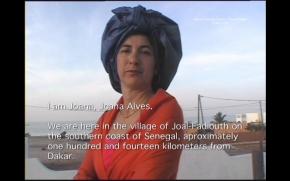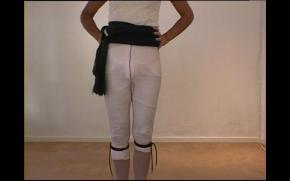Species of Spaces: Places, non-places and spaces of identity in the video work of Ângela Ferreira
There is something transversal in Ângela Ferreira’s video work, something that deals, fundamentally, with a kind of non-correlation between the concrete identity of the filmed places and its investment in open juxtapositions over a constellation of spacial axes and discontinuous temporalities. If territorial duality, inseparable from a certain biographical trajectory, from frequent journeys between Africa - Mozambique and South Africa - and Europe, undoubtedly marks Ângela Ferreira’s work, it is precisely this territorial duality that has written history in the indeterminate space of video discourse, pointing to issues of geopolitics and exposing us, simultaneously, to the work of deconstruction of iconography and the colonial and postcolonial imaginary that is being systematically developed by the artist. Ângela Ferreira’s body of work, in the context of a démarche of self-referential nature, falls into these places, places which are home to time and history, heterogeneous spaces, where relations with real space are briefly shown, to be suspended soon after through the artist’s intervention.
 ' Joal la Portugaise ' (2004)
' Joal la Portugaise ' (2004)
In Ângela Ferreira’s video work, we find abstract spaces, but also precise spaces, clearly identifiable and locatable, as is the case with the National Stadium in Jamor, Portugal, in Untitled, a video from 1998. The National Stadium, a monument of Germanic inspiration that was opened in 1944 during the Estado Novo regime, was designed to be a cathedral of sporting events and large public demonstrations organized by the Salazar government. In a long take, fixed and head on, Ângela Ferreira, dressed in green - a green that alludes to the paramilitary uniform of the Portuguese Youth - performs an aerobic gymnastics sequence. The stadium’s grandstand, of a monumental neoclassicism, in the background serves as a scenic curtain for the artist’s performance. The unfocused quality of the image creates, in this video, an effect of near-fusion between the artist’s moving body, in the foreground, and the architecture of the stadium. The choreography in the foreground is interwoven with the fixity of the architectural group, as historical and real space, a dual relationship. On the one hand, the artist’s gestuality summons and, in the same movement, disintegrates the sporting iconography of the Salazar regime; on the other hand, the architectural space of the set is converted into a non-place or a hybrid space where the diverse spacialities and temporalities are inlaid and overlapped. The scenic curtain, torn, suggests a number of other spaces, heterotopic spaces open above time.
 ' Untitled ' (1998)
' Untitled ' (1998)
Michel Foucault defines heterotopias as types of places that, despite being actually locatable, are found outside of all places. In this short article, I want to briefly examine the role of the heterotopia in Ângela Ferreira’s video work. For Foucault, heterotopias, unlike utopias, are actual spaces within an institution of society where all other places are represented. A new kind of condensation, or juxtaposition, of different spatiality, the heterotopia is not universal, nor constant throughout history, as it always plays a role relative to the whole of social space. On the other hand, the heterotopia presupposes a system of opening and closing, a factor that derails and isolates, making it, at the same time, permeable.
In the work of Ângela Ferreira, we find a systematic preference for heterotopic places and objects, as in the stadium of the analyzed example, the colony in Joal la Portugaise (2004) or even the colonial modernist architecture in the installation Maison Tropicale (2007). However, these essentially heterotopic places are, through experimentation of artistic language and adoption of models and narrative strategies based on friction and semantic shock, diverted from their original functions and converted into new heterotopic spaces and objects. Recircumscribed, reframed by the artistic gesture, misappropriated and uprooted from their original functions, these places and objects - tangible and intangible in nature, like the spoken incantation of forcados [participants in a traditional Portuguese bullfight] in bullfighting in Pega (2004) - are transformed into historical residues, from which new discourses emerge, now articulated around a work of investigating memory and deconstructing iconography.
 'Pega' (2000)
'Pega' (2000)
We also encounter neutral spaces, non-places, which are transformed into concrete and heterotopic spaces. In the aforementioned Pega, a white, abstract studio is converted into a bullfighting arena through the slow motion image and sound, and the repetition of almost unintelligible phrase, “Oh, bull!” Once again, the artist places herself on stage, embodying a forcado. The presence and constancy of Ângela Ferreira seems to unify the spaces and essentially discontinuous temporalities in her video work. Her inclusion in the image, almost always foregrounded in the scenic space of her work, seems to challenge both the audience and their historical consciousness, as the return of something seen from afar, something we thought forgotten, but that, remaining, suddenly invades the space of representation, driven by the straightforwardness of the artist’s body.
In Joal la Portugaise, Ângela Ferreira embodies Joana Alves, alleged founder of the village of Joal-Fadiouth, Senegal, the birthplace of Leopold Senghor, where the work was filmed. The artist tells, interpellating the camera in first-person, the history of the founding of the village. The closed space of the colonial village opens on heterogeneous temporalities, on the time of the Portuguese founding of Joal-Fadiouth, on the time of French colonization of Senegal, on the period of decolonization of the country and in the present. The temporal rupture, also evident in a certain taste for anachronism, is accompanied by a movement of spatial abstraction: the landscape and architecture of the town, traveled by the character, become, little by little, unreal, as if reflected in a mirror. Ângela Ferreira’s auto-mise-en-scene seems in this sense to create a game of mirrors, as if the artist found her identity in an effect of the image’s return (a return that also passes by the spectator), precisely, in a movement of passage from near to far and far to near. A trip not only of subjective order, but that has to do, above all, with collective memory, history and time.